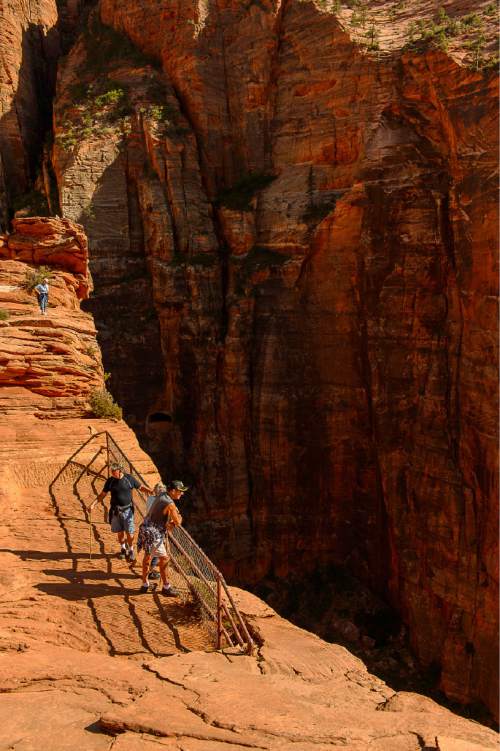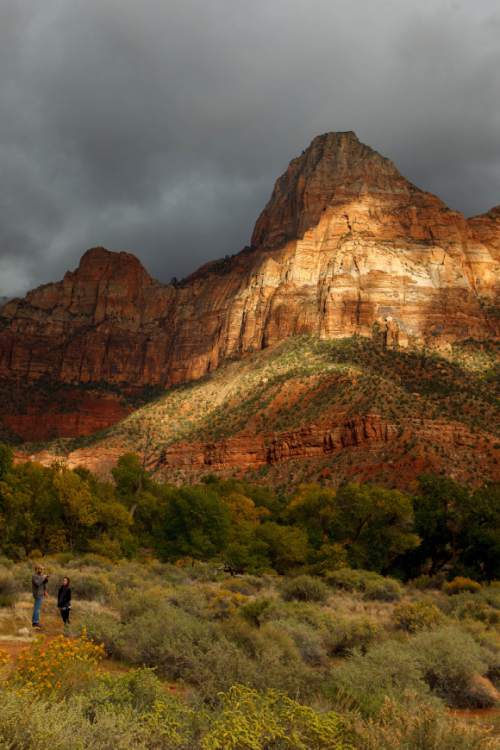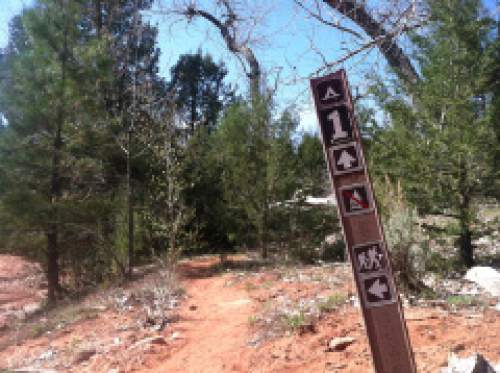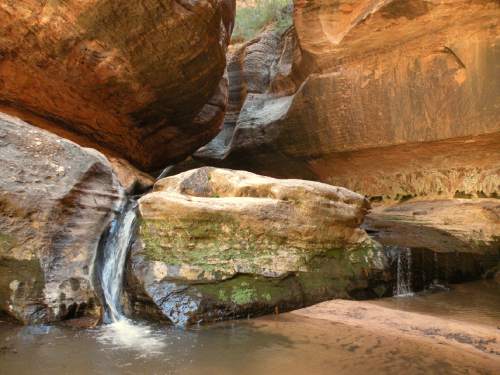This is an archived article that was published on sltrib.com in 2015, and information in the article may be outdated. It is provided only for personal research purposes and may not be reprinted.
Searchers on Wednesday afternoon recovered the bodies of two of three hikers still missing in southwestern Utah's Zion National Park, two days after flash flooding killed four others in their canyoneering group's trek to Keyhole Canyon.
Park spokeswoman Aly Baltrus confirmed that a fifth body — four were located Tuesday — had been found about 11:30 a.m. Wednesday at an unspecified location downstream of Keyhole. The sixth body was located about 1 p.m., also downstream of the canyon.
Citing efforts to notify the victims' families, Baltrus declined to provide further details.
However, the sheriff's office of Ventura County, Calif., announced that Sgt. Steve Arthur and his wife, Linda, were among the seven canyoneers caught in the flood. Steve Arthur's body was recovered and identified Wednesday. The Ventura County Sheriff's Office reported at 4:30 p.m. Wednesday that Linda Arthur was missing. Steve Arthur was a 21-year veteran of the department.
"Steve was known for his tireless efforts working the local youth both on and off duty and possessed a huge compassion for humanity," read a media statement by the department. "Please keep the Arthur family in your thoughts and prayers."
Despite warnings from rangers that flash flooding was "probable" as storm clouds gathered Monday, the group — four men and three women from California and Nevada, all in their 40s and 50s — decided to use their permit to explore Keyhole Canyon, a narrow slot canyon on the park's east side.
"We worked so hard to talk to them about [not] trying to go into the canyon," Baltrus said. "Ultimately, it is the visitors' decision ... whether they want to attempt that trip."
The bottom line, she added, is that park officials cannot legally bar anyone with a permit from going into the canyons — despite the weather danger.
Once the official National Weather Service flash flood warning for the park was issued at 2:22 p.m. Monday, rangers closed all canyons and suspended issuing permits. However, the group was already in Keyhole by then.
At that point, "there really was no physical way" to tell the group that flash flooding was imminent. With such a large park and small staff, rangers cannot alert everyone, and while hikers conceivably could receive weather alerts on their phones, cellular reception is poor in the park.
"In reality, people need to be aware of the weather and watching it," Baltrus explained, " ... and make a decision prior [to going in]."
The group was last seen alive in the canyon when passed by other hikers, who then notified rangers that the seven may be in peril as the clouds burst about 4:30 p.m. Monday. Within the next hour, Zion Superintendent Bradley Baugh said at a Wednesday news conference, 0.63 inch of rain poured onto the park; by then, it was too dangerous for rangers to go into the canyon themselves.
He said hopes were slim for finding any of the remaining hikers alive: "We're hopeful, but it's not looking good," he said, characterizing the search now as a "recovery" effort.
The search focused Wednesday on returning to previously checked locations downstream of Keyhole, focusing on debris piles and jams left by the flood. It was in one of those locations that the fifth body was found.
The same storm triggered flash flooding in the Utah-Arizona border community of Hildale on Monday that overwhelmed an SUV and van with 16 people aboard them.
Three of them escaped, but the remainder were washed away; 12 bodies were recovered Tuesday, some several miles downstream; the search continued Wednesday for the one remaining victim, a 6-year-old boy.
Meanwhile, after being alerted to the plight of the Keyhole hikers late Monday, rangers began a search, finding their unoccupied vehicles before suspending the effort due to rainfall. The search resumed Tuesday, and four bodies were found and retrieved. More rain overnight forced the search to be suspended until it ramped up again at dawn Wednesday.
Baltrus said Wednesday's search was done by 60 search-and-rescue workers from multiple agencies, including the park, the Rockville/Springdale Fire Department and Washington County.
"[They were] doing a more in-depth search of Clear Creek, Pine Creek and the Virgin River," she added. "Once weather conditions improve, they will also search Keyhole Canyon and Pine Creek Canyon."
Still, park officials warned that another cycle of storms could once more suspend what is now expected to be a recovery effort.
"There aren't a lot of places to go if a flash flood occurs [in Keyhole Canyon]," Baltrus said. "We won't put more people in danger."
Even when dry weather prevails, the Keyhole hike is not for amateurs. Usually a two-hour excursion, the route requires visitors to complete several rappels of up to 30 feet each and swim through numerous pools of water.
Zion National Park has a tragic history of past flash flooding-related tragedies. Last year, a hiker drowned in the Narrows; in 2001, a 10-year-old boy died when he was washed away on the Canyon Overlook trail; in 1998, two hikers drowned in the Narrows; in 1993, two Scout leaders died in a flash flood in Kolob Canyon; and, in 1961, four Boy Scouts and their leader were killed in a flash flood in the Narrows.
Twitter: @remims Zion Flash Flood Timeline •
Zion National Park Superintendent Brady Baugh released this timeline for the flash flooding incident believe to have killed seven hikers on Monday:
Monday, 7:40 a.m. — Group of seven picked up their canyoneering permit for Keyhole Canyon.
2:22 p.m. — The area came under a flash flood warning from the National Weather Service. The warning was publicized through several media sources and posted in all of the park's contact stations. Canyons were closed to canyoneering, but group already had left for hike.
4:30 to 5:30 p.m. — Zion Canyon received 0.63 inches of rain in less than one hour. Rangers noted Keyhole Canyon and several other canyons began to flash flood. The flow of the North Fork of the Virgin River rose abruptly from 55 Cubic Feet per Second (CFS) to 2,630 CFS in 15 minutes. The park receives levels this high approximately once every three years.
5:30 p.m. — Another canyoneering group which had been through Keyhole Canyon just before the flood reported to park rangers that they had passed a group of seven canyoneers and believed that they may have been caught in the flood. Rangers located the group's vehicles, but did not see any sign of the group. Keyhole Canyon was already flash flooding. Due to weather at the time and through the evening, it was determined that rescue operations could not be safely initiated.
9 p.m. — Park rangers rechecked on the canyoneers. There was still no sign of the group.
Tuesday, 7 a.m. — The search began. Because of the weather, Keyhole Canyon was still inaccessible to Search and Rescue crews, but they were able to follow its course and glimpse in it at several locations. There was no response to verbal calls. The search continued downstream into Clear Creek.
1:30 p.m. — One body was located.
2:30 p.m. — A private canyoneering group went through Keyhole Canyon and reported one body inside.
4 p.m. — The search was continued in Clear Creek, Pine Creek and the Virgin River. A third body was located.
5:15 p.m. — A fourth body was discovered. Zion Flash Flood Timeline •
Zion National Park Superintendent Brady Baugh released this timeline for the flash flooding incident believe to have killed seven hikers on Monday:
Monday, 7:40 a.m. — Group of seven picked up their canyoneering permit for Keyhole Canyon.
2:22 p.m. — The area came under a flash flood warning from the National Weather Service. The warning was publicized through several media sources and posted in all of the park's contact stations. Canyons were closed to canyoneering, but group already had left for hike.
4:30 to 5:30 p.m. — Zion Canyon received 0.63 inches of rain in less than one hour. Rangers noted Keyhole Canyon and several other canyons began to flash flood. The flow of the North Fork of the Virgin River rose abruptly from 55 Cubic Feet per Second (CFS) to 2,630 CFS in 15 minutes. The park receives levels this high approximately once every three years.
5:30 p.m. — Another canyoneering group which had been through Keyhole Canyon just before the flood reported to park rangers that they had passed a group of seven canyoneers and believed that they may have been caught in the flood. Rangers located the group's vehicles, but did not see any sign of the group. Keyhole Canyon was already flash flooding. Due to weather at the time and through the evening, it was determined that rescue operations could not be safely initiated.
9 p.m. — Park rangers rechecked on the canyoneers. There was still no sign of the group.
Tuesday, 7 a.m. — The search began. Because of the weather, Keyhole Canyon was still inaccessible to Search and Rescue crews, but they were able to follow its course and glimpse in it at several locations. There was no response to verbal calls. The search continued downstream into Clear Creek.
1:30 p.m. — One body was located.
2:30 p.m. — A private canyoneering group went through Keyhole Canyon and reported one body inside.
4 p.m. — The search was continued in Clear Creek, Pine Creek and the Virgin River. A third body was located.
5:15 p.m. — A fourth body was discovered.















